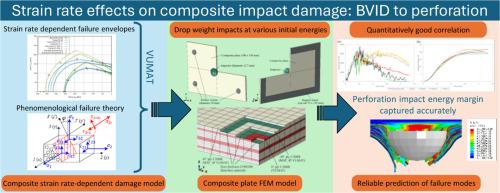应变速率对复合冲击损伤的影响:BVID到穿孔
IF 9.4
1区 工程技术
Q1 ENGINEERING, MECHANICAL
International Journal of Mechanical Sciences
Pub Date : 2025-10-01
DOI:10.1016/j.ijmecsci.2025.110907
引用次数: 0
摘要
该工作描述了应变率相关的复合材料结构冲击损伤模拟本构模型的发展和应用。这项工作是作者先前工作的延续,增强了VUMAT子程序,可以准确确定复合板在冲击事件中的完全穿孔阈值。通过考虑应变率对横向断裂能的影响,扩展了本构模型。改进的压缩纵向破坏起裂和演化模型已纳入剪切应力贡献。此外,采用有效失效应变(EFS)单元去除准则来准确捕获复合材料层合板的穿孔。因此,除了改进纵向压缩损伤模型外,本研究的新颖之处在于将其与材料性能的综合应变率依赖关系结合起来,并采用EFS单元去除准则进行冲击损伤评估。这些改进能够区分BVID(低能量条件)和完全射孔损伤(高能条件)。利用增强型VUMAT模型和参考研究的实验数据对仿真结果进行验证。采用半球形冲击器对AS4/8552碳纤维/环氧树脂材料体系进行了三种不同能级的冲击模拟。结果表明了应变率效应和分层建模的重要性。验证了所采用的电磁场单元去除准则在评价复合材料板冲击时完全穿孔的有效性。本文章由计算机程序翻译,如有差异,请以英文原文为准。

Strain rate effects on composite impact damage: BVID to perforation
The work describes the development and application of a strain rate-dependent constitutive model for the simulation of impact damage in composite structures. The work is a continuation of the previous work by the authors with enhancements of the VUMAT subroutine that enable accurate determination of the full perforation threshold of the composite plates during impact events. The constitutive model has been extended by incorporating strain rate effects on the fracture energies in the transverse fracture modes. The improved compressive longitudinal failure initiation and evolution modelling has been incorporated by inclusion of shear stress contributions. Additionally, an Effective Failure Strain (EFS) element removal criterion is implemented to accurately capture the perforation of composite laminates. Thus, besides the improved longitudinal compressive damage modelling, the novelty of this study is found in combining it with the comprehensive strain rate dependence of the material properties and the employment of the EFS element removal criterion in impact damage assessment. These improvements enabled the distinction between BVID (low-energy conditions) and full perforation damage (high-energy conditions). Validation is performed by testing the simulation results obtained by utilising the enhanced VUMAT model with experimental data from the reference study. Impact simulations using a steel hemispherical impactor on the AS4/8552 carbon fibre/epoxy resin material system were performed at three different energy levels. The results have shown the importance of the inclusion of strain rate effects and delamination modelling. The effectiveness of the employed EFS element removal criterion in the assessment of full perforation of composite plates during impacts was proven.
求助全文
通过发布文献求助,成功后即可免费获取论文全文。
去求助
来源期刊

International Journal of Mechanical Sciences
工程技术-工程:机械
CiteScore
12.80
自引率
17.80%
发文量
769
审稿时长
19 days
期刊介绍:
The International Journal of Mechanical Sciences (IJMS) serves as a global platform for the publication and dissemination of original research that contributes to a deeper scientific understanding of the fundamental disciplines within mechanical, civil, and material engineering.
The primary focus of IJMS is to showcase innovative and ground-breaking work that utilizes analytical and computational modeling techniques, such as Finite Element Method (FEM), Boundary Element Method (BEM), and mesh-free methods, among others. These modeling methods are applied to diverse fields including rigid-body mechanics (e.g., dynamics, vibration, stability), structural mechanics, metal forming, advanced materials (e.g., metals, composites, cellular, smart) behavior and applications, impact mechanics, strain localization, and other nonlinear effects (e.g., large deflections, plasticity, fracture).
Additionally, IJMS covers the realms of fluid mechanics (both external and internal flows), tribology, thermodynamics, and materials processing. These subjects collectively form the core of the journal's content.
In summary, IJMS provides a prestigious platform for researchers to present their original contributions, shedding light on analytical and computational modeling methods in various areas of mechanical engineering, as well as exploring the behavior and application of advanced materials, fluid mechanics, thermodynamics, and materials processing.
 求助内容:
求助内容: 应助结果提醒方式:
应助结果提醒方式:


